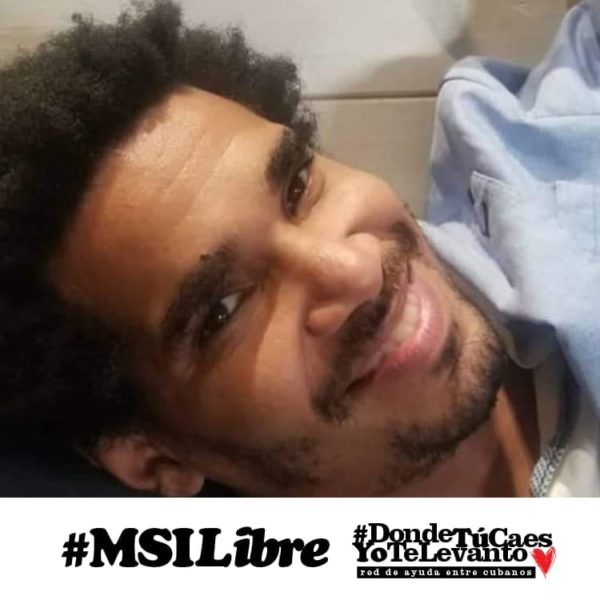The San Isidro Movement after the July 11th Protests

HAVANA TIMES – The San Isidro Movement has suffered the consequences of questioning totalitarian power in Cuba. It is currently surviving with a few initiatives despite many of its members suffering police harassment, being taken prisoner or fleeing into exile.
Artist Luis Manuel Otero Alcantara, one of its co-founders, has been in a maximum-security prison in Guanajay for almost two months, which he was transferred to without a court hearing beforehand.
Luis Manuel was arrested on the street on July 11th, when he was on his way to take part in one of the protests that were happening across the country. He was walking towards Havana’s Malecon, to be more precise, just like hundreds of people were who joined the protests to express their wishes for freedom. His lawyer was only able to visit him for the first time on August 5th and he isn’t allowed any visits from family or friends.
Otero has suffered harassment from the political police for years, to the point that he held his second hunger and thirst strike in April, to demand that his works be returned after they were seized by State Security. After a week of his strike, and taking advantage of his fragile state, he was abducted and held at Calixto Garcia Hospital for 25 days, isolated and subjected to public ridicule in state-controlled media.
His current situation includes legal proceedings for the crime of Aggravated Contempt, as well as other charges for public disorder and incitement. The government has normalized Luis Manuel’s arrests as a practice to make him give up on the challenging focus of his art and his defense for freedom of speech.
Art historian Claudia Genlui recently reminded us the following about Otero Alcantara: “charges of “indecent assault of patriotic symbols” are still up in the air and the alleged investigation (the most concerning) which, according to his police instructor, Captain Roberto Baptista, is being undertaken to determine Luis’ involvement in the events of July 11th, an accusation that could lead to opening up another file and/or the application of Law 88 with a prison sentence of 1-20 years, depending on the magnitude of the violation.”
“Indecent assault of patriotic symbols” was the government’s response to one of the artist’s performance art pieces, when Luis Manuel decided that the flag didn’t belong to a select few, but to anyone who can wear it as a second skin.
In prison, Luis finds himself in relatively good health, drawing, very concerned about his future but resolute.
Anti-establishment rapper Maykel Castillo is in the middle of a similar legal proceeding, although he was arrested a long time before, on May 18th, while eating lunch at home. He is also being held in prison without a trial, and is being accused of attempt, resistance, and contempt. After an arrest full of irregularities and violations, he has expressed his willingness to continue to create art and fight for freedom from his prison cell.
Both artists have been worn down emotionally, after years of harassment and violence from State Security.
Amaury Pacheco, another artist and member of the San Isidro Movement (MSI), was verbally charged with “incitement”, after the protest on Obispo Street, on April 30th, which he didn’t take part in. On July 11th, he was arrested by force as he was traveling on a bus heading towards Prado and the Malecon. Once at a police station, he was given a warning for public disorder. He is currently under investigation, at his home in Alamar, uncertain of whether he will be taken to prison at any moment.
Independent journalist Esteban Rodriguez is also being held prisoner after he was violently arrested on Obispo Street, on April 30th, along with a group of people who were demanding their right to free movement, to be able to accompany a friend who was holding a hunger strike. He has caught COVID in prison, like many inmates have. In June, Human Rights Watch demanded his freedom.
Maykel, Esteban and Luis Manuel aren’t ordinary prisoners like the Government pretends they are. They are political prisoners. They were recently declared prisoners of conscience by Amnesty International.
The Government’s strategy is clear: dismantle the MSI. But it won’t be easy. According to Claudia Genlui, there are still many projects that need to be developed: “After the July 11th protests, campaigns such as #MSIlibre have emerged, that involve a series of actions that happen over time, some of which are visible such as: the #DondeTuCaesYoTeLevanto (Where you Fall, I’ll pick you up) network, which aims to help the families of those who were arrested on July 11th and before the protests, and/or people under house arrest.
There is also a campaign to make visible the people arrested or disappeared who need their cases to be made known; a medicine aid network for people most in need; work to promote the work of artists who belong to the movement and of new independent creators, creating cultural activities both inside and outside Cuba – concerts, photography exhibitions, participation in important art events, etc.”





